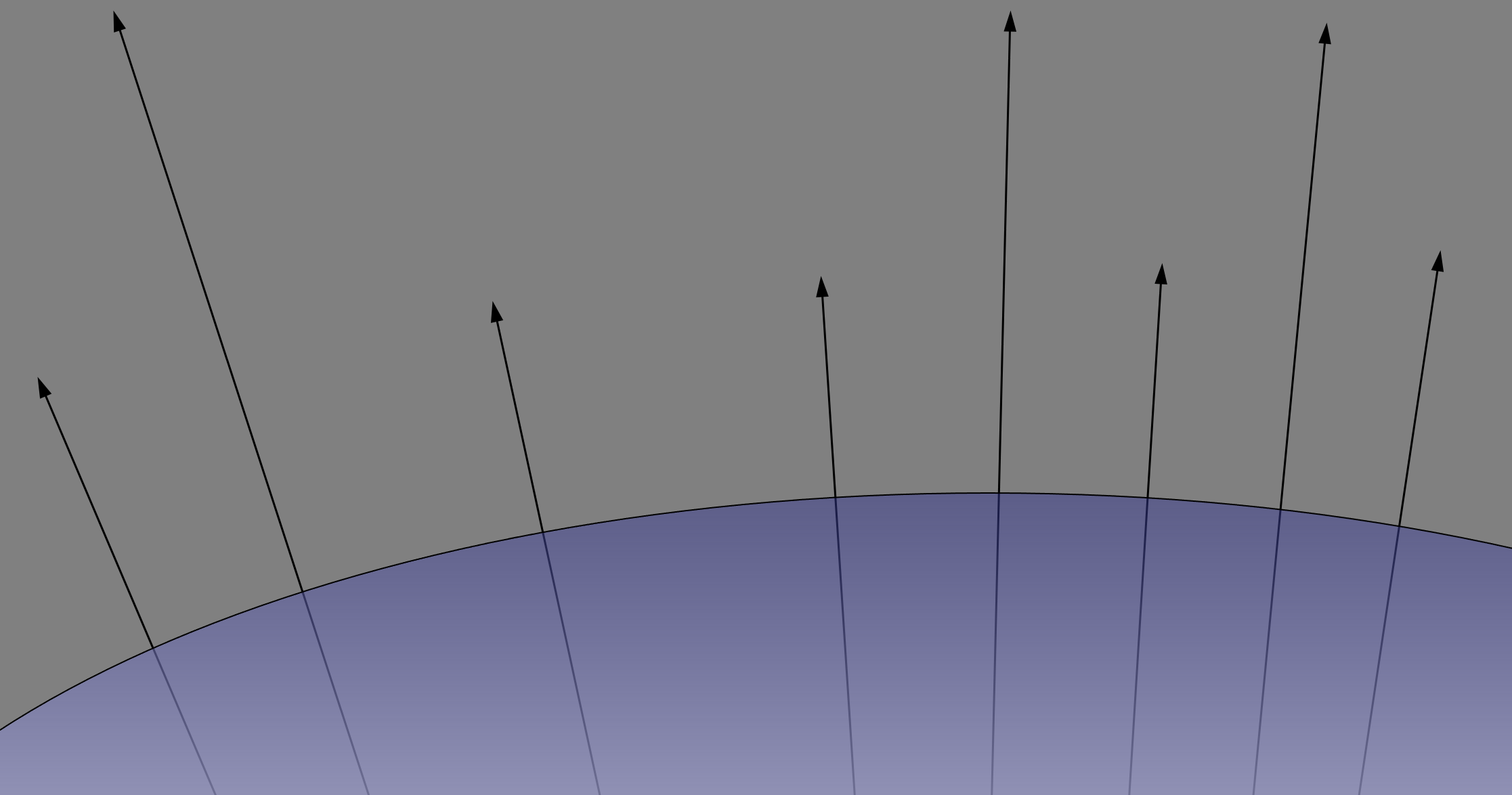
Chapter 6: Gauss's Law
6.0. Overview
We've already seen how a single charge produces an electric field in space, and a collection or distribution of charge can be analyzed to determine its electric field as well.
Another strategy that can be used for determining the electric field around charges is by using a strategy based on Gauss's Law. This useful technique is much preferred for analyzing certain common situations. To understand Gauss's Law, however, you first have to understand the concept of flux.
Let's get started!
6.1. Electric Flux
Let's begin by defining electric flux.
Definition: Electric flux

Electric flux is related to the electric field (magnitude and direction) passing through a given surface area.
- E is the electric field passing through the area, magnitude and direction relative to the area vector of the plane.
- A is the area vector, a vector with a magnitude equal to the area of the plane, and a vector that points perpendicular to the surface of the plane.
- Φe = "phi" (pronounced "fee") = electric flux (a scalar value, positive or negative). The units for electric flux are N m2/C ("Newtons meters-squared per Coulomb").

Flux is a measure of both the amount of field through an area and the total area through which the field is passing. A good analogy for flux is the amount of sunlight ("energy") coming through a window:
- the stronger the sun, the more light comes through
- the bigger the window, the more light comes through
- the more directly the sun shines on the window, the more light comes through
If the area vector A is tilted at some angle to the direction of the electric field vector E, you can see that less of the area is exposed to the field, and thus we have less total flux passing through that area, even if its magnitude is the same.
It's possible to imagine field lines passing through a larger area with varying orientations, in which case we'd need to integrate over the entire area to calculate the total flux.
We'll expand on this idea in the next section.
6.1.1. Flux through a closed surface

It's easy to imagine a surface area that wraps around on itself to produce a close surface: a sphere, or a cylinder, or a cube, a kidney bean shape, etc.
For such a closed surface, the area vector dA for any segment of the shape's surface area is directed, by convention, away from the interior of the closed surface.
We can also imagine field lines passing through such a surface perhaps entering on one side of the closed surface and leaving on the opposite side of the surface. For dA where θ < 90°, cos θ is a positive value, and thus flux is positive. For dA where θ > 90°, flux is negative.
6.1.2. The Surface integral
The net flux through a closed surface is proportional to the net number of lines through the surface ("lines leaving - lines entering").
That circle that is included with the integral denotes the "close surface" nature of this integral. And although the diagram above presents flux in the nature of sphere (presented here as a circle), this integral applies to any three-dimensional shape. (We don't provide mathematical evidence of that fact here.)
There are mathematical challenges associated with integrating a dot-product like this, so we will be restricting ourselves to consider a few of important, symmetric, situations.
Flux through different surfaces
Examine each of the diagrams here. Consider field lines passing through each of the colored surfaces. Are there a greater number of lines entering each surface, or leaving? Or are the number of lines entering and leaving the same?


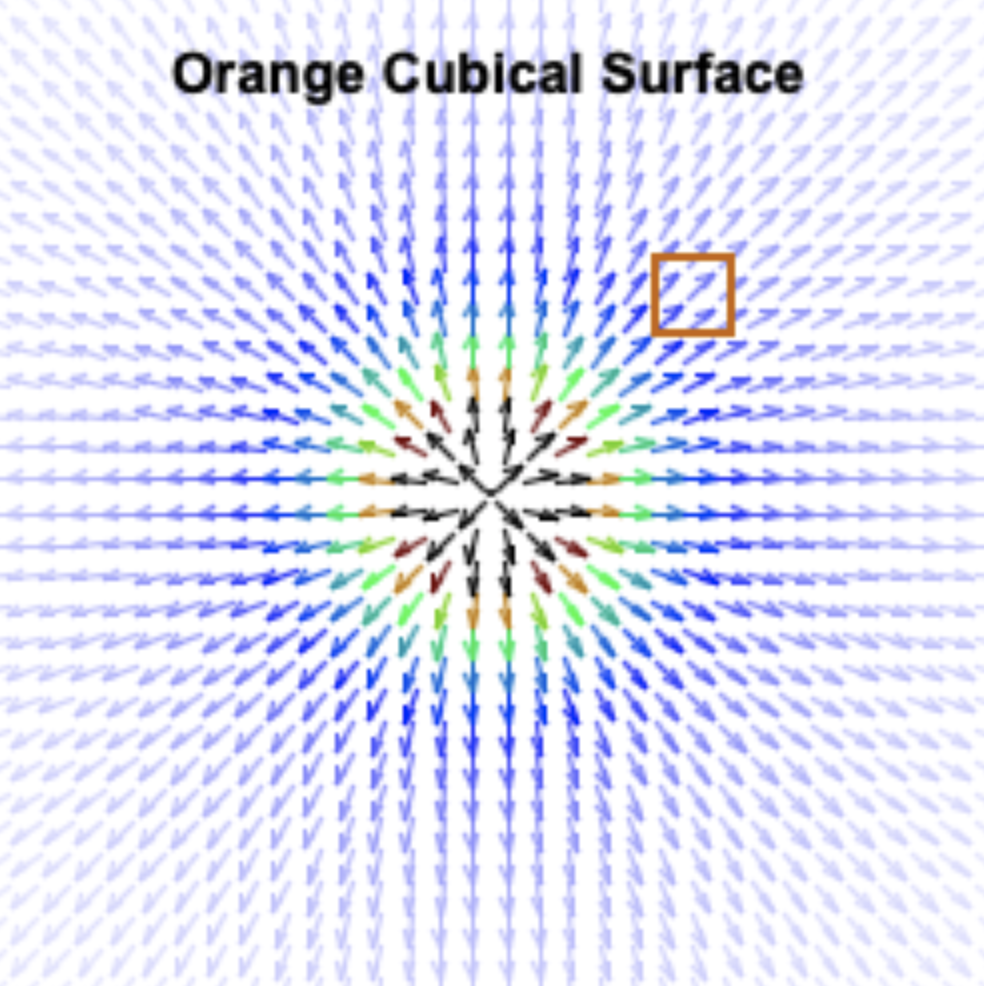

Draw electric field lines through any of these surfaces and you'll see that the number of lines entering each surface is balanced by the number of lines leaving. Therefore, we can see that the net flux through each of these surfaces is zero.
6.1.3. The permittivity of free space
We're about to introduce some important topics, and it will be helpful sometimes to be able to express some relationships using a new constant that you probably haven't seen before.
We've already used a constant for Coulomb's Law, k = 8.99 × 109 N m2/C2.
This value k, is related to another constant that we sometimes use in electric field calculations, the permittivity of free space (or vacuum permittivity), ε0.
Permittivity refers to the ability of a material—in this case, free space, a vacuum—to transmit (or "permit") an electric field.
With this new variable, we will often rewrite an equation in terms of ε0 rather than k. Thus, Coulomb's law might be written in one of two different ways:
6.1.4. Internal charge
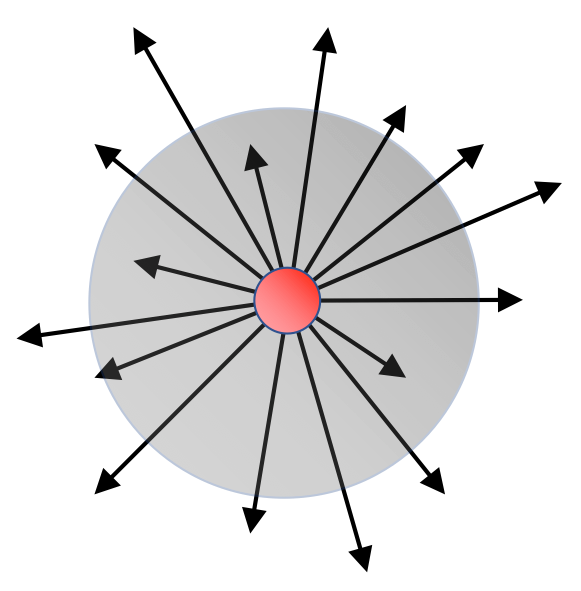
Under what conditions can we see a net flux through a closed surface? If there is an internal charge—a charge, positive or negative, inside the closed surface, then we can see that there is a net number of lines passing through that surface.
Calculating net flux for an internal charge
Find the electric flux passing through the surface of an imaginary sphere of radius R if a charge of +q is located at its center.
The lines of the electric field E due to the point charge and the area vectors dA are parallel, so cos θ = cos 0 = 1. The integral is easy to evaluate, then:
Let's take a look at another example.
Flux through an irregular surface

What is the net electric flux passing through the surface of the apple shown here, which encloses a positive charge?
Although the apple's surface is somewhat irregularly shaped compared with the sphere that we used to measure flux before, the next flux is the same. As long as the charge is interior to the surface of the apple, we can calculate its net flux using the same analysis we used above:
What if there's no internal charge?
Flux through an irregular surface
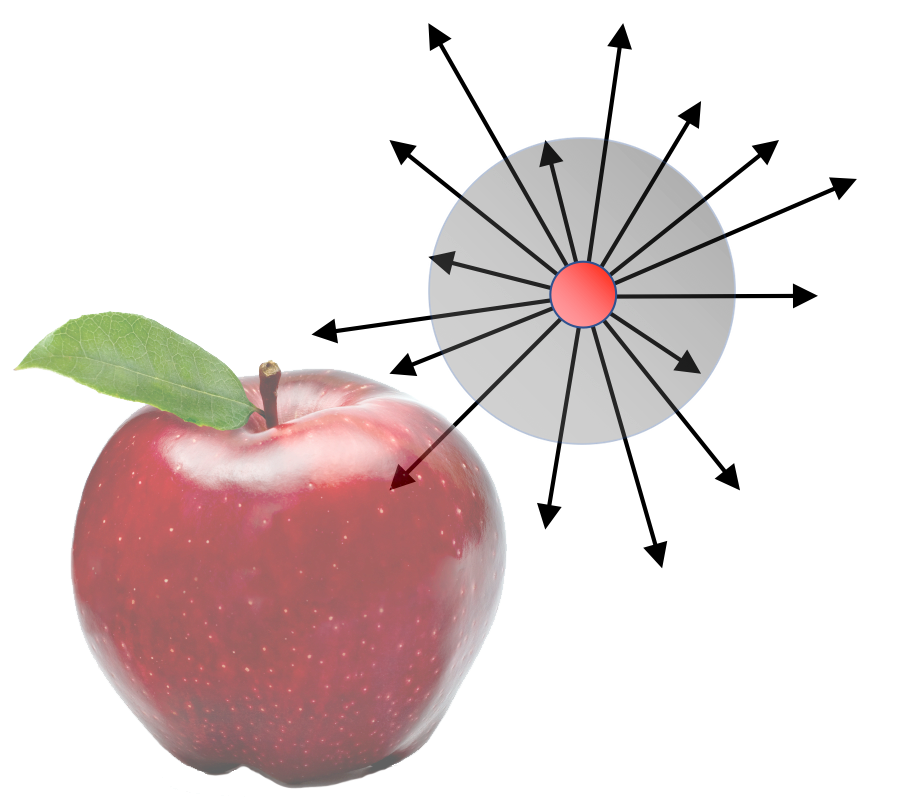
What is the net electric flux passing through the surface of the apple shown here, which doesn't enclose any internal charge?
If there is no charge internal to the surface of the apple, there will be no net number of field lines passing through it, and therefore no next flux through the surface.
There is flux passing through the surface, of course—negative flux where the field lines enter the surface, and positive flux where they leave—but no net flux, overall.
6.1.5. Electric flux ≠ Electric field
Here's a quick review of what we know thus far:
- Electric charges exert forces on each other, as described by Coulomb's law.
- The area around a charge, or a charge distribution, can be described in terms of its electric field.
- Electric flux is a measure of the electric field passing through an area.
- The electric flux passing through an enclosed volume depends on whether or not there is a net charge enclosed in that volume. If there is no net charge, there is no next flux.
In the diagram here, we see two point charges of +3Q in the vicinity of a -3Q point charge, and there is clearly an electric field throughout this region as a result of those charges.
What else can we see? There is positive flux through the surface of the banana, due to the positive internal charge in that shape. There is negative flux through the surface of the orange because of the negative internal charge there. Note that there is no net flux through the apple, even thought there is an electric field passing through its volume.

Electric flux is related to electrical fields, but they're clearly not the same thing. In the next section we'll learn how to use the idea of electric flux to help us determine electric fields.
6.2. Gauss's Law
Now that we know about flux, let's look at Gauss's Law.
Definition: Gauss's Law
The net electric flux through any closed surface is equal to the net charge inside the surface divided by ε0.
In this equation, the "closed surface" is an imaginary one that encloses the internal charge qin. The electric field E is a field located at that imaginary, "Gaussian" surface.
Let's see how we can think about Gauss's Law in terms of the flux through an enclosed surface.
How does flux change?

Consider a spherical Gaussian surface that surrounds a charge. Describe what happens to the net electric flux if...
- the internal charge is tripled
- the radius of the sphere is doubled
- the Gaussian surface is changed from a sphere to a cube
- the charge is moved to a different location inside the surface
- the charge is moved outside the surface
- If the internal charge is tripled, the flux through the surface is tripled as well.
- If the radius of the sphere is doubled, the flux remains the same as it was before. (The surface of the sphere has increased, but the electric field through that surface is weaker when it reaches the larger surface.)
- If the Gaussian surface is changed from a sphere to a cube, the flux remains the same. (We don't justify this mathematically in this course.)
- If the charge is moved to a different location inside the surface, the flux remains the same.
- If the charge is moved outside the surface, there is no longer any internal charge, so there is no net electric flux through the surface.
What does net flux mean?
The net flux through a Gaussian surface is 0. Which of the following statements must be true?
- If the net flux is 0, there must be no charges inside the surface.
- If the net flux is 0, the net charge inside the surface must be 0.
- If the net flux is 0, the electric field everywhere on the Gaussian surface must be 0.
- If the net flux is 0, the number of electric field lines entering the surface must equal the number of lines leaving the surface.
- If the net flux is 0, there must be no charges inside the surface. This might be true, but there could be a dipole or some other number of charges that add up to no net charge.
- If the net flux is 0, the net charge inside the surface must be 0. Yes, this is true.
- If the net flux is 0, the electric field everywhere on the Gaussian surface must be 0. There may very well be electric field at the surface—electric field and electric flux are not the same thing.
- If the net flux is 0, the number of electric field lines entering the surface must equal the number of lines leaving the surface. This is necessarily true.
6.2.1. Using Gauss's Law to determine Electric fields
Finding flux through a Gaussian surface is useful, but what we really want to be able to do is determine electric fields.
Using Gauss's Law to identify Electric field
Our strategy for identifying electric fields in the vicinity of charges or charge distributions follows is this:
- Given the arrangement of charges, select an enclosing "Gaussian surface" that is appropriate for that arrangement.
- An appropriate Gaussian surface will have at least some of its surface located so that flux is passing through it, perpendicular to the surface, and at a position where the electric field strength is to be calculated.
- The shape may have other surfaces, through which no field lines are passing—a surface parallel to the field lines. In these cases, because there is no flux through that area, that area is not part of the calculation.
Let's use these strategies to identify some electric fields.
Electric field of a point charge
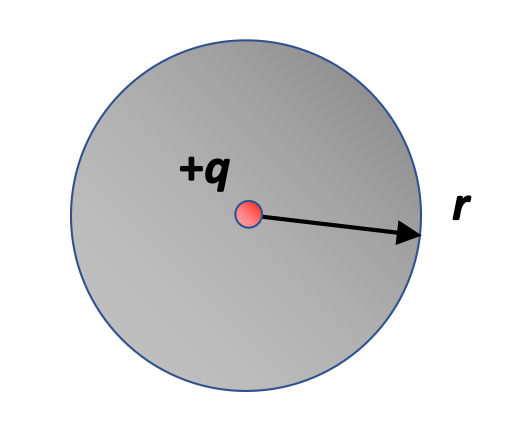
Use Gauss’s Law to calculate the electric field at a distance r from a point charge q. Then derive Coulomb's Law from your result.
The solution strategy is to place a Gaussian sphere around the charge with a radius that matches where we want to calculate the electric field, ie. at a distance r from the charge.
Then, use Gauss's Law to solve for that electric field.
Once we've identified the electric field, we can use the definition of electric field to get Coulomb's equation:
Spherically-symmetric charge distribution

An insulating sphere of radius a has a uniform charge density ρ and a total charge of +Q.
- Calculate the magnitude of the electric field at a point outside the sphere
- Find the magnitude of the field at a point inside the sphere.
- Sketch the graph of electric field E as a function of radius r.
 We choose to use a Gaussian sphere around the sphere of charge, because that imaginary shape has a symmetry that is appropriate. With this shape, all the field lines from the spherical charge are perpendicular to the plane of the Gaussian sphere.
We choose to use a Gaussian sphere around the sphere of charge, because that imaginary shape has a symmetry that is appropriate. With this shape, all the field lines from the spherical charge are perpendicular to the plane of the Gaussian sphere.
Solving using Gauss's Law: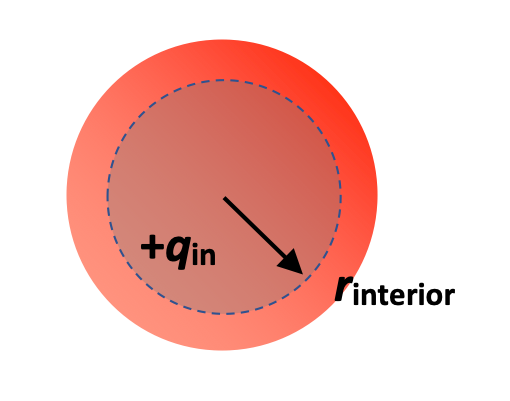 We can use a similar approach here, although the radius of the Gaussian surface is now inside the charge distribution. Now, when we apply Gauss's law, we will only be solving using the charge internal to our Gaussian surface—remember that charges external to our surface don't affect the net electric flux through that surface. Thus, we have to calculate qin as a fraction of the total charge Q:
We can use a similar approach here, although the radius of the Gaussian surface is now inside the charge distribution. Now, when we apply Gauss's law, we will only be solving using the charge internal to our Gaussian surface—remember that charges external to our surface don't affect the net electric flux through that surface. Thus, we have to calculate qin as a fraction of the total charge Q:
- Using the equation from part (a), from r = ∞ to r = a, and then the equation from part (b) the rest of the way to r = 0:
 You can see an example of this relationship at this simulation, where you can select an insulating sphere, and then move the test charge around to collect Electric field data.
You can see an example of this relationship at this simulation, where you can select an insulating sphere, and then move the test charge around to collect Electric field data.
Electric field of a thin, spherical shell

A thin spherical shell of radius a has a total charge of Q distributed uniformly over its surface. Find the electric field at points inside and outside the shell.
Outside the shell, our analysis here is the same as it was for the previous example—all the charge is internal to our Gaussian surface, so again .

For a Gaussian sphere drawn inside the shell, so that the surface of the sphere is at the location where we're trying to identify the electric field, there is no charge internal to that sphere. Therefore, there is no electric field E at that point.
Electric field of a line charge

Find the electric field a distance r from a uniform positive line charge of infinite length whose charge per unit length λ is constant. What kind of Gaussian surface will be choose to solve this problem?

Before we can solve the problem we need to choose a Gaussian surface, and before we choose the Gaussian surface, we need to understand that the electric field looks like around this long line of charge. From the side view shown here, we can imagine the field lines extending out away from the positively-charged line.
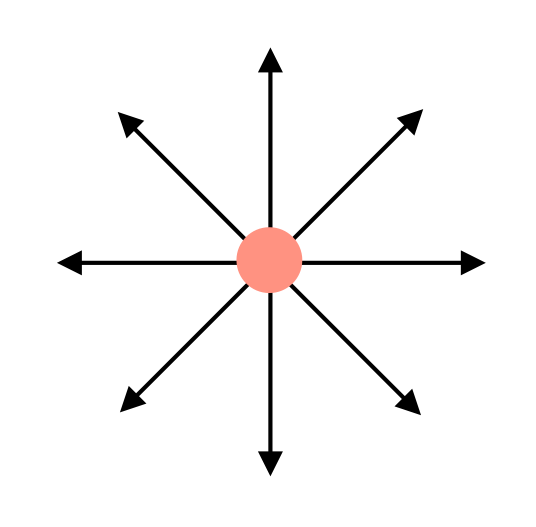
Those lines don't extend just up and down, however, from this end-view, we can imagine that those lines extend out radially in all directions from the line of charge.
We're going to select a new kind of Gaussian shape here, in which the field lines pass at 90° through the walls of a cylinder.
An important detail is this: the surface area of a cylinder includes both the walls ( where, for any given length L of the cylinder, A = 2πrL ) and the circular "cap" at both ends, a total of A = 2πr2.
Because the field lines only pass through the circular walls, and not the caps on the end, we only include the circular walls in our analysis of the flux area. The field lines have a cos 90° relationship with the area vector of those end caps, so they are not part of our analysis.
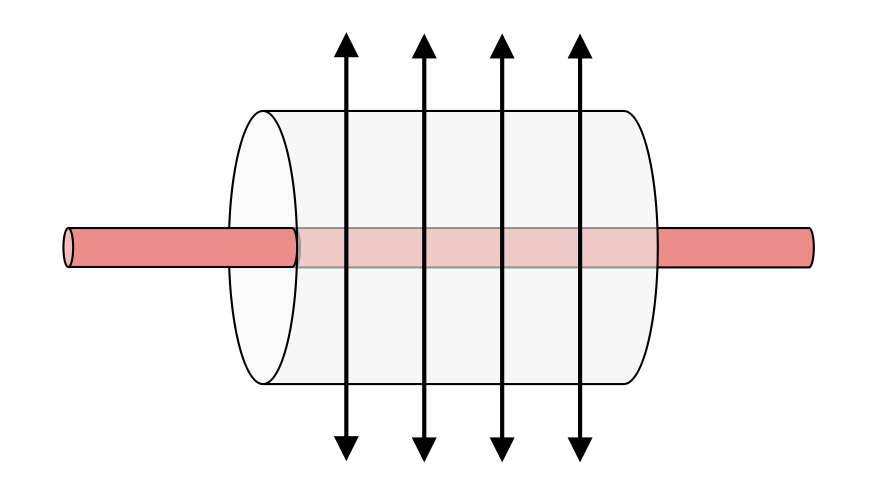
So:
Electric field of a dipole
What type of Gaussian surface would one use to analyze an electric dipole?
This is a trick question! A dipole doesn't have sufficient symmetry for us to be able to analyze it using a Gaussian surface. For us to calculate the electric field at some point in space, we'd need to use with the two charges in the dipole.
Electric field of a nonconducting plane of charge
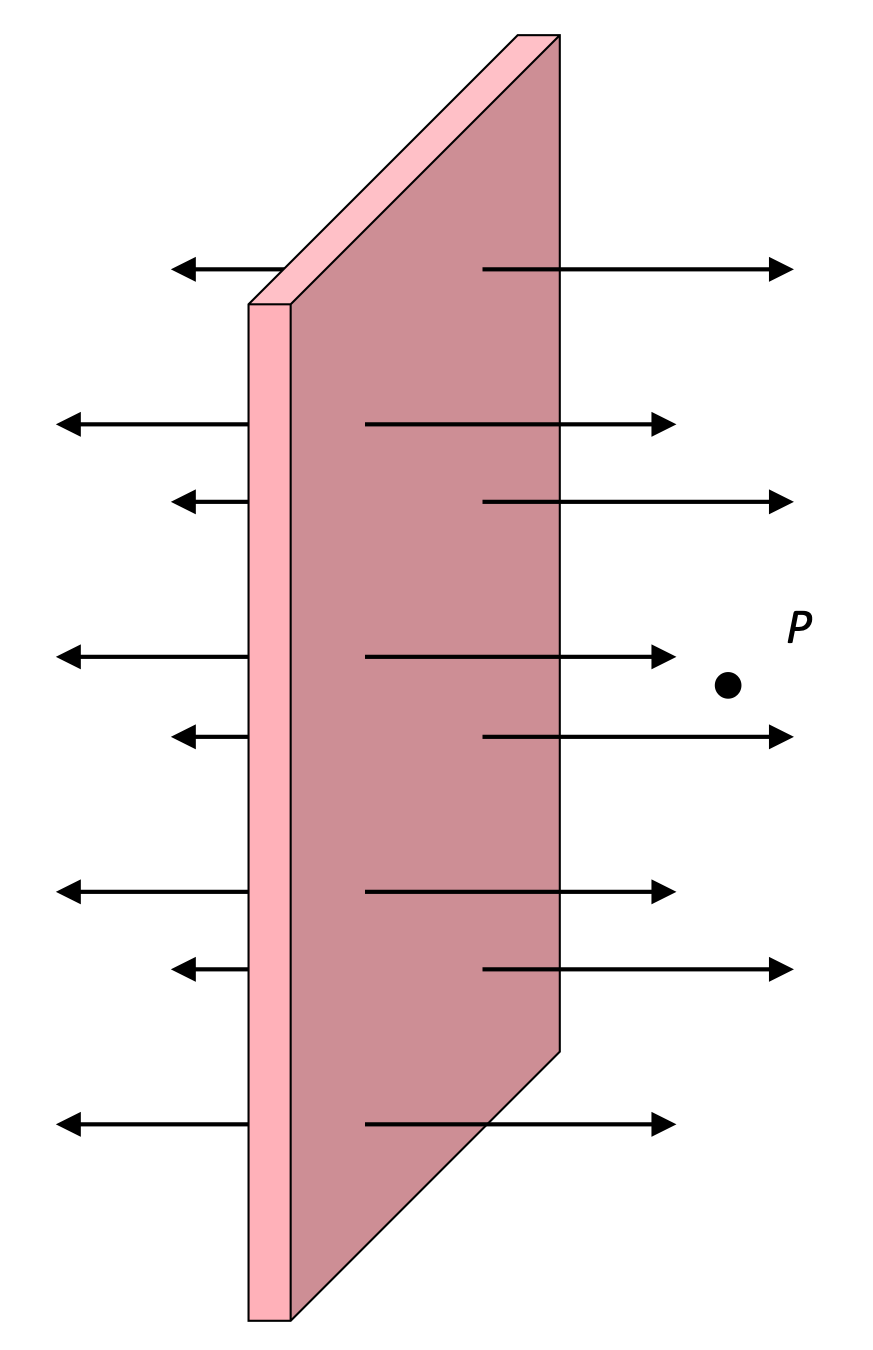
Find the electric field at point P due to a non-conducting infinite plane with uniform charge per unit area σ = Q/A.
The electric field lines have already been drawn in the diagram here. They extend out to either side of the sheet of charge, and because the sheet extends off "infinitely", the integral sum of the dE vectors creates an electric field of constant magnitude (the field lines don't change their density).
What kind of Gaussian shape will allow us to analyze this situation?

Our imaginary Gaussian surface consists of a cylindrical or rectangular "plug" that passes through the surface of the plane, thereby enclosing some amount of charge there. The plug has two sides through which the field lines are passing: the end caps, each with a surface of A. Note that there are no field lines passing through the walls of the cylindrical plug, so their area is not included in our area analysis of the Gaussian surface.
Applying Gauss's Law, then:
Electric field near parallel planes of charge

Find the electric field at points A, B, and C for these infinite sheets of charge, where the sheet on the left has a positive charge and charge density +σ, and the sheet on the right has a negative charge with charge density -σ.
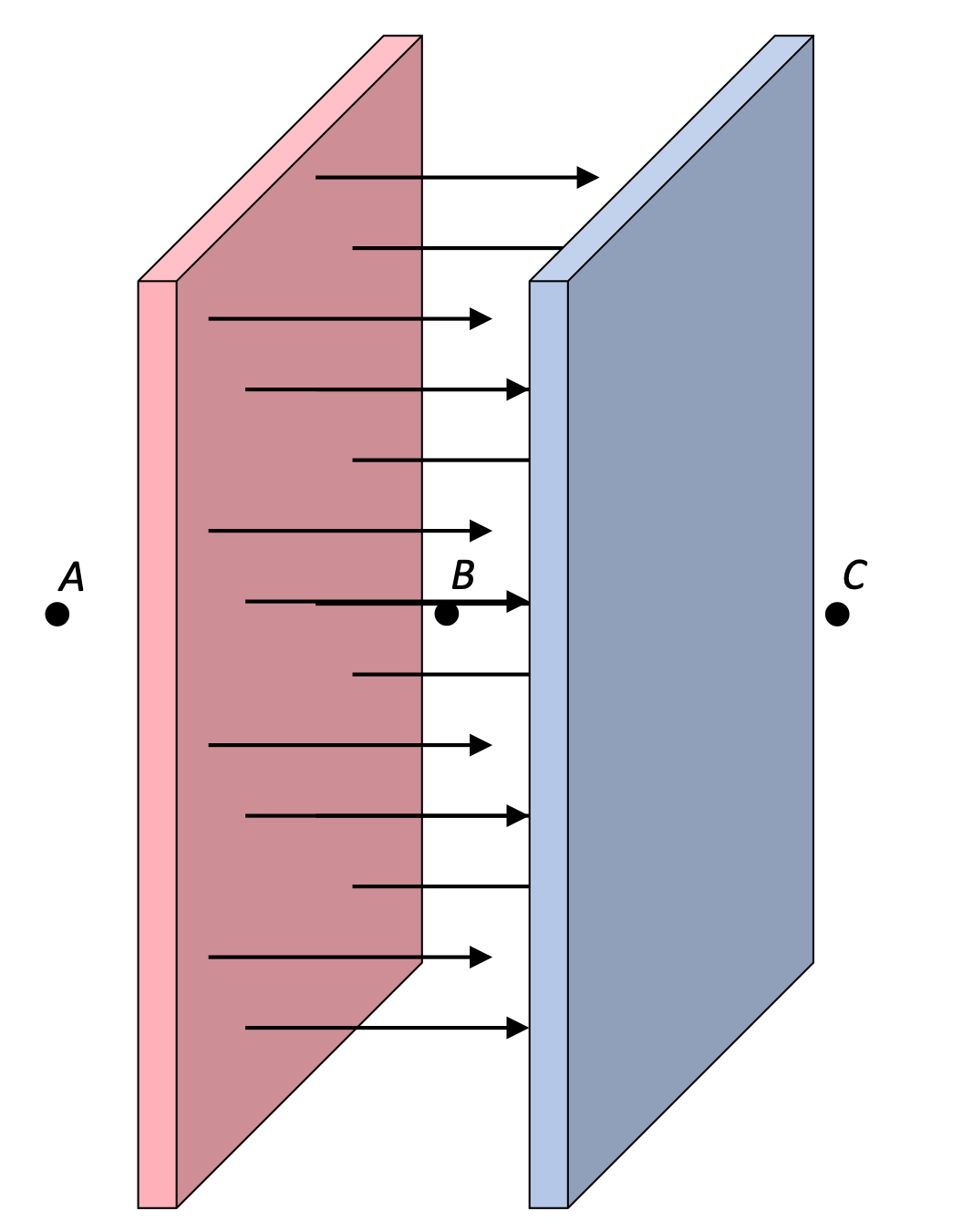
The positively-charged sheet produces an electric field of at all three points, with the direction of that field to the left for point A and to the right for points B and C.
The negatively-charged sheet produces the same effect, although with the electric field pointing in the opposite direction of the positive field, as expected: to the right for points A and B and to the left for point C.
As a result, the net electric field at points A and C is 0, and the net electric field at point B is double what it was for the single sheet of charge:
Electric field near a charged disk
What type of Gaussian surface would you use to analyze the E field near a charged disk?
This, too, is a bit of a trick question. If the disk is small and we're very near the surface of the disk we could approximate it as a (nearly) infinite plane.
If we're any significant distance from the disk, however, we'd have to perform a non-Gaussian analysis, integrating the "rings of charge" in the disk to calculate a net electric field.
6.3. Electric Fields and Conductors
As we've already discussed, metals/conductors are materials that allow for the relatively free movement on electrons throughout their volume. Under some circumstances, electrons can be compelled to move continuously through a conductor, producing a flow of charge called "current," and we'll be studying this aspect of electricity soon.
For the moment, we are still considering "electrostatic" situations, in which charges may move in a conductor, but they will do so relatively quickly in order to achieve an electrostatic equilibrium.
4 Rules for Conductors in Electrostatic Equilibrium
Some general rules for the electric charges and fields in a conductor:
- The electric field is zero everywhere inside a conductor.
If there is any kind of external field around the conductor, it causes a shift in charges such that an internal electric field results in a net field of 0 in the body of the conductor. (If there wasn't a 0 field we'd have a force on charges in the conductor, and they would still be moving to a position where they arrive at equilibrium.) - Any charge on an isolated conductor resides on its surface.
We know this has to be true because there is no electric field in the conductor itself. If there were an electric field in there, there would have to be some net internal charge. But the E = 0, thus there can't be any internal charge. - The electric field just outside a charged conductor is perpendicular to the surface there, and with a magnitude E = σ/ε0.
This magnitude is easily derived with Gauss's Law. - On an irregularly-shaped conductor, the charge tends to accumulate at locations where the radius of curvature of the surface is the smallest, ie. at sharp points.
We'll discuss this later.
Let's try to apply these rules to a specific problem.
Charges and Fields in conductors
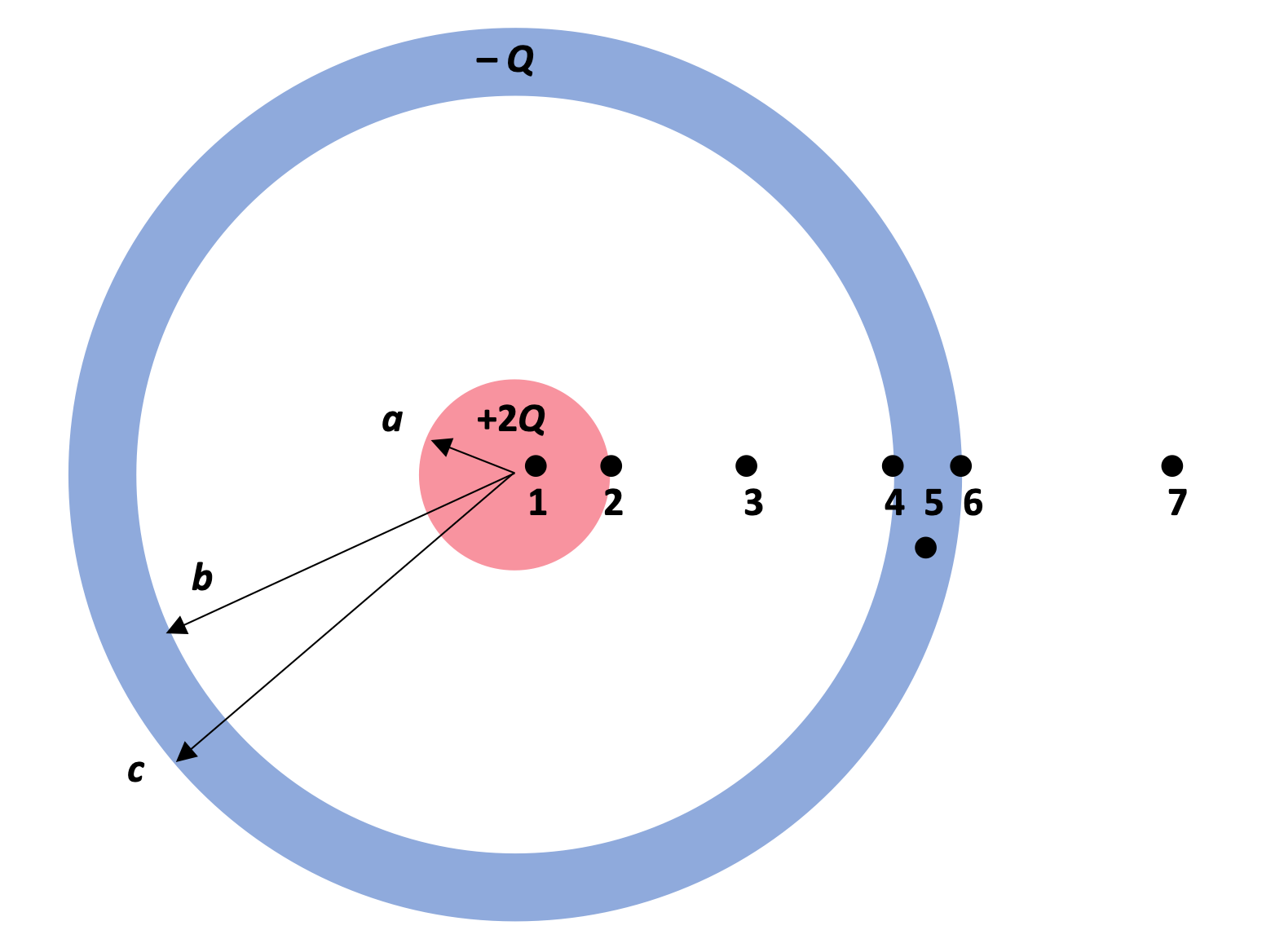
A solid conducting sphere of radius a has a net positive charge +2Q. A conducting spherical shell of inner radius b and outer radius c is concentric, and has a net charge -Q.
Identify the both the electric charge and electric field at the locations indicated in the diagram here.
- E = 0 because the electric field inside a conductor is 0. No net charge in body of a conductor.
- On surface is a charge of +2Q, but E = 0 (still in conductor). Just above surface, no charge, and E = σ/ε0.
- No charge located in this space, but use Gauss's Law to get E = k(2Q)/r2.
- At inner surface, charge is -2Q, because E = 0 on the inside of a conducting shell, and internal net charge is 0.
- E = 0, and there's no net charge there.
- E = 0 on the surface, and charge q at surface is (-2 inner) +(? outer) = -1 total. Outer charge must be +1Q.
- There's no charge out here, but a Gaussian sphere can be used with net internal chargee to get E=kQ/r2.